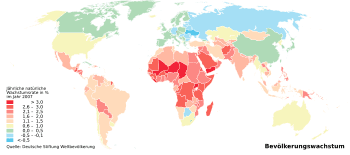- Image via Wikipedia
Will 9 billion people max out the Earth’s natural resources? Or is overconsumption the real planetary threat? Three experts discuss the Gordian knot of wealth, fertility, and environmental impact — and why making do with less stuff matters so much.
The number of people on Earth is expected to grow from 6.5 billion to about 9 billion by 2050. That much is relatively uncontroversial. But recently, we’ve seen disparate views emerge as to how this population growth will affect the planet.
Four decades after publishing The Population Bomb, Paul Ehrlich, for one, is still a firm believer that overpopulation—and along with it, overconsumption—is the central environmental crisis facing the world. In an opinion piece for Yale e360, he and Anne Ehrlich write: “Many human societies have collapsed under the weight of overpopulation and environmental neglect, but today the civilization in peril is global. The population factor in what appears to be a looming catastrophe is even greater than most people suppose.” The reason, say the Ehrlichs, is that each additional person today on average causes more damage to humanity’s life support systems than did the previous addition. And because Homo sapiens are smart creatures, we have already farmed the richest soils and tapped the most abundant water sources. Therefore, to support more people, it will be necessary to move to poorer lands, dig deeper wells, and spend more energy to transport food and water to increasingly distant homes and factories. Population, the Ehrlichs aver, remains an underacknowledged apocalypse in waiting.
Others, however, take a markedly different view. In the recently published book, The Coming Population Crash, and in a series of articles also for e360, environmental journalist Fred Pearce looks at the same demographic trends and sees very good news. “The population bomb is being defused at a quite remarkable rate,” he writes. “Women around the world have confounded the doomsters and are choosing to have dramatically fewer babies.” He then goes on to cite declining fertility rates in countries across Europe, Asia, and Latin America. And in Africa, where high fertility remains the norm, Pearce is optimistic that those extra people can provide a way out of the continent’s poverty trap. Bad agriculture, not population growth, he contends, is the continent’s main predicament—and in this essay, he describes how more people, employed on ecologically friendly, small-scale farms will be key to African sustainable development. Chris Reij, a Dutch geographer whom Pearce interviews for the article, concurs. “The idea that population pressure inevitably leads to increased land-degradation is a myth,” he says. “It does not. Innovation is common in regions where there is high population pressure.”
Consumption, not population, Pearce concludes, is the main problem confronting human society today. After all, he writes, “virtually all of the extra 2 billion or so people expected on this planet in the coming 40 years will be in the poor half of the world.” Assuming per capita emissions remain roughly where they are today, those 2 billion poor people will only boost the developing world’s share of greenhouse gas emissions from 7 to 11 percent. In other words, achieving zero population growth—even if it were possible—would barely touch the climate problem. The real culprits, according to Pearce, are not “generations of poor not yet born” people, but the stable population in the developed world with its gigantic ecological footprint.
The Erhlichs, of course, also cite consumption as a critical concern. But in their view, consumption and population (according to the familiar equation I=PAT, with “P” being population and “A” representing consumption) are mutually reinforcing parameters. For Pearce, population has been dangerously overhyped—and in the worst cases, by those seeking to excuse overconsumers and blame the poor for our common environmental predicament. The Ehrlichs look at demographic trends to 2050 and see twin synergistic forces: too many people and too much consumption. Pearce examines the same trends and sees a silver lining in that the rate of growth is trailing off, even if the numbers are still rising. And where those numbers are growing is crucial too because in places like Africa, he believes, human ingenuity and human labor can become a part of a food-producing environmental solution.









